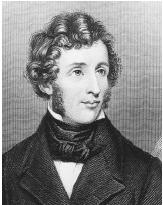Friedrich Wöhler

GERMAN CHEMIST
1800–1882
Friedrich Wöhler was born on July 31, 1800, at Eschersheim, near Frankfurt-am-Main, Hesse. The son of a veterinary surgeon, young Wöhler attended public schools in Frankfurt and passed exams qualifying him for admission to a university in 1820. During his earlier school years Wöhler had acquired an all-consuming interest in practical chemistry and mineralogy. He chose to study medicine at Heidelberg University and obtained an M.D. degree from that institution in 1823.
As a student at Heidelberg Wöhler attended the chemistry lectures of Leopold Gmelin, and the experience prompted Wöhler to choose chemistry over medicine. On the advice of Gmelin, Wöhler spent a year at the laboratory of Jöns Jakob Berzelius in Stockholm, where he honed his experimenter's skills. Wöhler developed a lifelong friendship with Berzelius and acted as the translator into German of Berzelius's influential Textbook of Chemistry (1808–1818, published in six parts over ten years) as well as of his annual reports of new developments in chemistry. Wöhler himself was a prolific writer of textbooks; his organic and inorganic chemistry texts went through thirteen and fifteen editions, respectively, in his lifetime.
Returning to Germany in 1825 Wöhler held positions in technical schools in Berlin and Kassel. In 1832 he was offered the professorship of chemistry of the medical faculty at the University of Göttingen, where he stayed until his death (on September 23, 1882). Wöhler is best known for his synthesis of urea and the isolation of aluminum. He is also known for his important studies of the elements boron, silicon, beryllium, and titanium.
Wöhler's synthesis of urea was the result of experiments begun in 1823, in which he investigated the salts of cyanic acid, known as cyanates. In 1824 Wöhler showed that the empirical formula of silver cyanate was AgNCO. Justus von Liebig, who had studied the compound silver fulminate, had come up with the same formula for an entirely different compound. (These two compounds were structural isomers .) Isomerism was a novel idea at that time, as it was believed that each compound had a unique formula: No two compounds could have the same formula. (Berzelius had first described the phenomenon of isomerism in 1831.)
In 1828 Wöhler attempted to synthesize ammonium cyanate via the treatment of silver cyanate with aqueous ammonium chloride. The reaction produced a white crystalline solid that did not possess the properties of ammonium cyanate. Wöhler then attempted to synthesize ammonium cyanate using lead cyanate and ammonium hydroxide. This produced the same white powder, but with fewer contaminants so that it could be analyzed. Upon analysis this white powder proved to have the composition and properties of urea, a compound that had been isolated from urine.
Pb(OCN) 2 + 2 NH 3 + H 2 O → PbO + NH 4 OCN → H 2 NCONH 2
Wöhler recognized in the urea he had synthesized the phenomenon of isomerism, and, incidentally, that he had prepared an organic compound outside a living system. At that time it was believed that all organic (carbonbased) compounds could be made within living organisms only. Vitalism was a theory that developed as a reaction to mechanistic explanations of physical phenomena, which were viewed as a threat to belief in the unique nature of life. It held that living processes could not be understood according to totally mechanistic models, and that it was a material invisible force in organisms that made life possible. August W. von Hofmann, in his obituary notice for Wöhler, alleged that it was Wöhler's synthesis of urea that led to the demise of the theory of vitalism.
Wöhler's other major achievement was his isolation of the element aluminum in 1827. Attempts by chemists Humphry Davy and Berzelius to prepare aluminum from alumina (Al 2 O 3 ) via electrolytic decomposition had all failed. Wöhler employed a chemical approach that included the reduction of anhydrous aluminum chloride by potassium amalgam , followed by treatment with water. It produced a gray powder that Wöhler was able to identify as the element aluminum.
3K + AlCl 3 → Al + 3KCl
SEE ALSO Aluminum ; Berzelius, JÖns Jakob .
Martin D. Saltzman
Bibliography
Hoffman, August (1961). "Friedrich Wöhler." In Great Chemists , ed. Eduard Farber. New York: Interscience.
Keen, Robin (1972). "Friedrich Wöhler." In Dictionary of Scientific Biography , Vol. 14. New York: Charles Scribner's Sons.
Comment about this article, ask questions, or add new information about this topic: